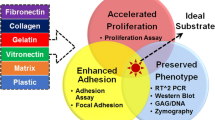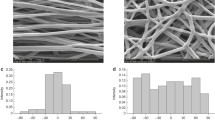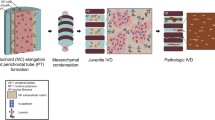Abstract
The anulus fibrosus (AF) of the intervertebral disc consists of concentric sheets of collagenous matrix that is synthesised during embryogenesis by aligned disc cells. This highly organised structure may be severely disrupted during disc degeneration and/or herniation. Cell scaffolds that incorporate topographical cues as contact guidance have been used successfully to promote the healing of injured tendons. Therefore, we have investigated the effects of topography on disc cell growth. We show that disc cells from the AF and nucleus pulposus (NP) behaved differently in monolayer culture on micro-grooved membranes of polycaprolactone (PCL). Both cell types aligned to and migrated along the membrane’s micro-grooves and ridges, but AF cells were smaller (or less spread), more bipolar and better aligned to the micro-grooves than NP cells. In addition, AF cells were markedly more immunopositive for type I collagen, but less immunopositive for chondroitin-6-sulphated proteoglycans than NP cells. There was no evidence of extracellular matrix (ECM) deposition. Disc cells cultured on non-grooved PCL did not show any preferential alignment at sub-confluence and did not differ in their pattern of immunopositivity to those on grooved PCL. We conclude that substratum topography is effective in aligning disc cell growth and may be useful in tissue engineering for the AF. However, there is a need to optimise cell sources and/or environmental conditions (e.g. mechanical influences) to promote the synthesis of an aligned ECM.




Similar content being viewed by others
References
Adams MA, Hutton WC (1985) Gradual disc prolapse. Spine 10:524–531
Adams P, Eyre DR, Muir H (1977) Biochemical aspects of development and ageing of human intervertebral discs. Rheumatol Rehabil 16:22–29
Alini M, Li W, Markovic P, Aebi M, Spiro RC, Roughley PJ (2003) The potential and limitations of a cell-seeded collagen/hyaluronan scaffold to engineer an intervertebral disc-like matrix. Spine 28:446–454
Benya PD, Schaffer JD (1982) Dedifferentiated chondrocytes re-express the differentiated collagen phenotypes when cultured in agarose gels. Cell 30:215–224
Curtis ASG, Wilkinson CDW, Crossan J, Broadley C, Darmani H, Johal KK, Jorgensen H, Monaghan W (2005) An in vivo microfabricated scaffold for tendon repair. Eur Cell Mater 9:50–57
Dalby MJ, Riehle MO, Yarwood SJ, Wilkinson DC, Curtis AS (2003) Nucleus alignment and cell signalling in fibroblasts: response to a micro-grooved topography. Exp Cell Res 284:274
Fritsch EW, Heisel J, Rupp S (1996) The failed back surgery syndrome. Reasons, intraoperative findings, and long-term results: a report of 182 operative treatments. Spine 21:626–633
Gan JC, Ducheyne P, Vresilovic EJ, Shapiro IM (2003) Intervertebral disc tissue engineering II: cultures of nucleus pulposus cells. Clin Orthop 411:315–324
Gargiulo BJ, Cragg P, Richardson JB, Ashton BA, Johnson WE (2002) Phenotypic modulation of human articular chondrocytes by bistratene A. Eur Cell Mater 3:9–18
Hayes AJ, Benjamin M, Ralphs JR (1999) Role of actin stress fibres in the development of the intervertebral disc: cytoskeletal control of extracellular matrix assembly. Dev Dyn 215:179–189
Horner HA, Roberts S, Bielby RC, Menage J, Evans H, Urban JP (2002) Cells from different regions of the intervertebral disc: effects of culture system on matrix expression and cell phenotype. Spine 27:1018–1028
Kazimoglu C, Bolukbasi S, Kanatli U, Senkoylu A, Altun NS, Babc C, Yavuz H, Piskin E (2003) A novel biodegradable PCL film for tendon reconstruction: Achilles tendon defect in rats. Int J Artif Organs 26:804–812
Kim G, Okumura M, Bosnakovski D, Ishiguro T, Park CH, Kadosawa T, Fujinaga T (2003) Effects of ascorbic acid on the proliferation and biological properties of bovine chondrocytes in alginate beads. Jap J Vet Res 51:83–94
Kuslich SD, Ulstrom CL, Michael CJ (1991) The tissue origin of low back pain and sciatica: a report of pain response to tissue stimulation during operations on the local spine under local anesthesia. Orth Clin North Am 22:181–187
Mallein-Gerin F, Garrone R, van der Rest M (1991) Proteoglycan and collagen synthesis are correlated with actin organization in dedifferentiating chondrocytes. Eur J Cell Biol 56:364–373
Martin G (1980) Recurrent disc prolapse as a cause of recurrent pain after laminectomy for lumbar disc lesion. N Z Med J 26:206
Moore RJ, Vernon-Roberts B, Fraser RD, Osti OL, Schembri M (1996) The origin and fate of herniated lumbar intervertebral disc tissue. Spine 21:2149–2155
Rufai A, Benjamin M, Ralphs JR (1995) The development of fibrocartilage in the rat intervertebral disc. Anat Embryol 192:53–62
Sato M, Maeda M, Kurosawa H, inoue Y, Yamauchi Y, Iwase H (2000) Reconstruction of the rabbit Achilles tendon with three bioresorbable materials: histological and biomechanical studies. J Orthop Sci 5:256–267
Schantz JT, Hutmacher DW, Ng KW, Khor HL, Lim MT, Teoh SH (2002) Evaluation of a tissue-engineered membrane-cell construct for guided bone regeneration. Int J Oral Maxillofac Implants 17:161–174
Schnabel M, Marlovits S, Eckhoff G, Fichtel I, Gotzen L, Vecsei V, Schlegel J (2002) Dedifferentiation-associated changes in morphology and gene expression by primary human articular chondrocytes in cell culture. Osteoarthr Cartil 10:62–70
Urban JP, Roberts S (1996) Intervertebral disc. In: Comper WD (eds) Extracellular matrix, vol1 Tissue function. Harwood Academic, Amsterdam, pp 203–233
Wojciak B, Crossan J, Curtis ASG, Wilkinson CDW (1995) Grooved substrata facilitate in vitro healing of completely divided flexor tendons. J Mater Sci Mater Med 6:266–271
Acknowledgment
This study was part-funded by Eurodisc: QLK6-CT-2002-02582. We are grateful to Professor Bruce Caterson for the provision of antibodies and to Helena Evans and Janis Menage for their technical expertise.
Author information
Authors and Affiliations
Corresponding author
Rights and permissions
About this article
Cite this article
Johnson, W.E., Wootton, A., El Haj, A. et al. Topographical guidance of intervertebral disc cell growth in vitro: towards the development of tissue repair strategies for the anulus fibrosus. Eur Spine J 15 (Suppl 3), 389–396 (2006). https://doi.org/10.1007/s00586-006-0125-9
Received:
Revised:
Accepted:
Published:
Issue Date:
DOI: https://doi.org/10.1007/s00586-006-0125-9




